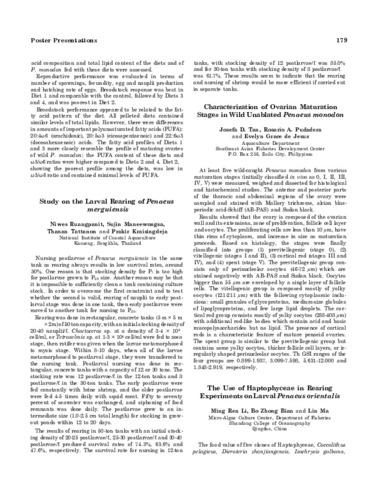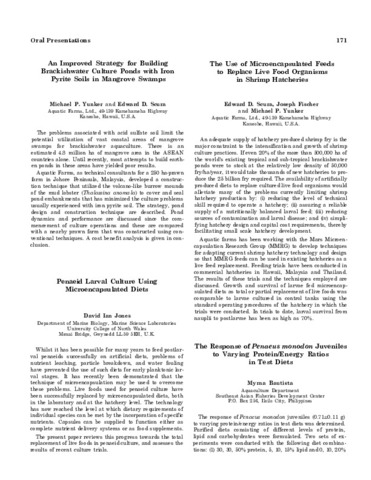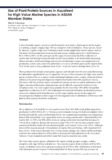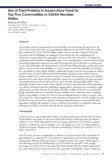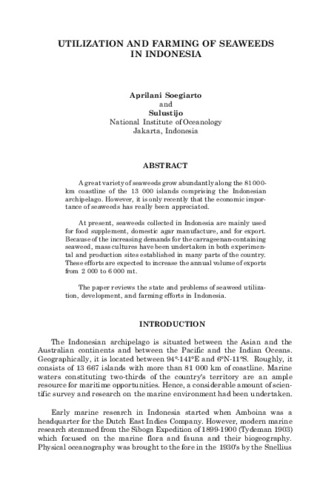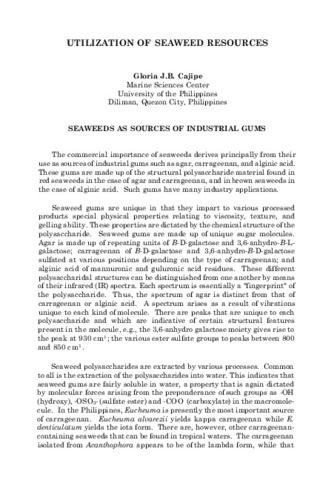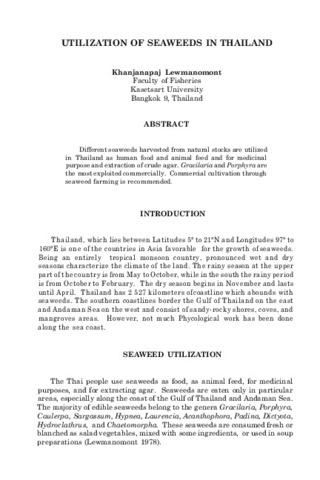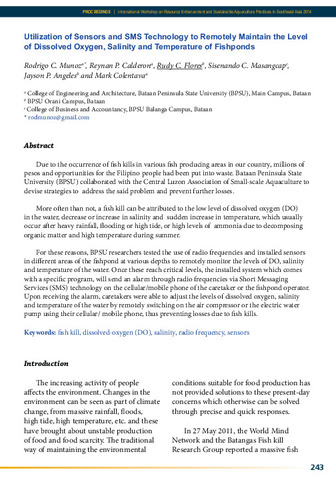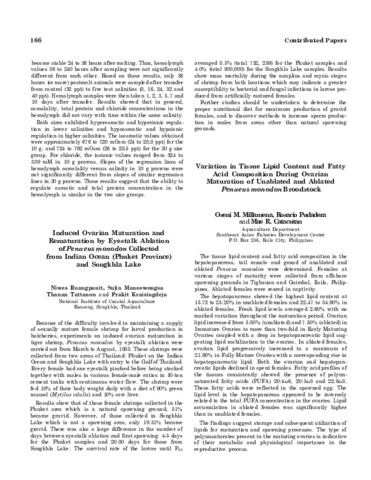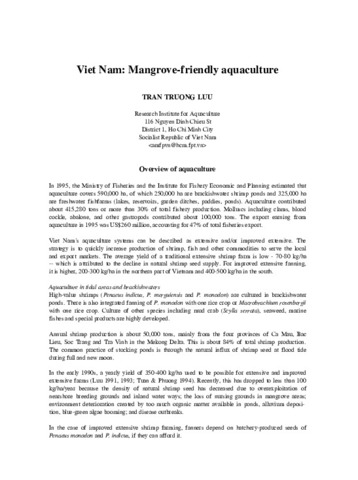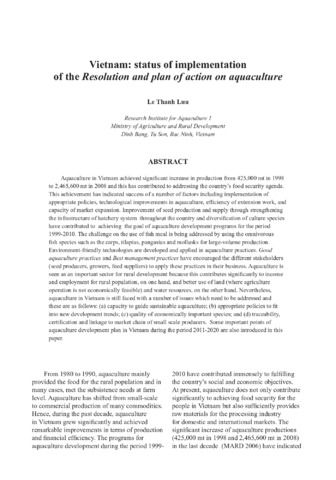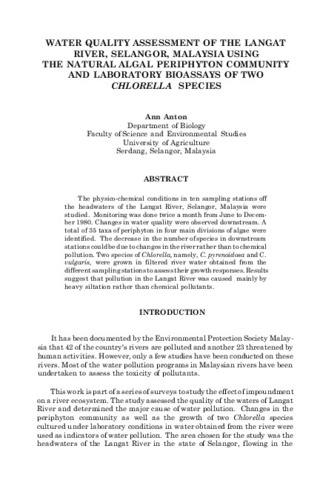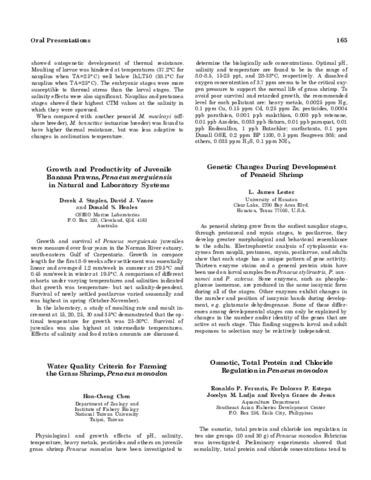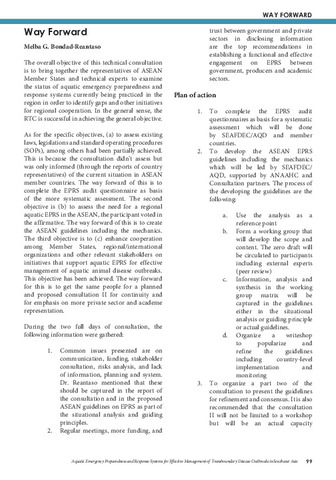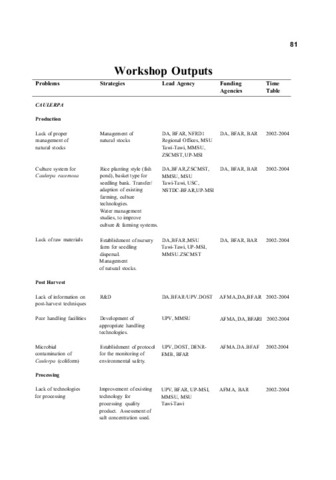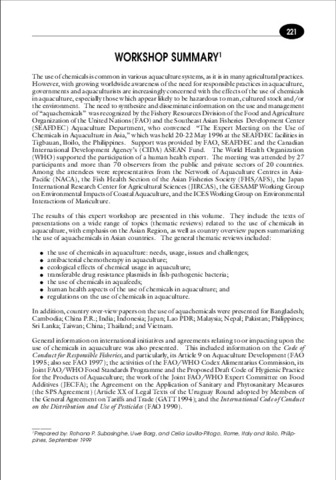Browsing Conference Proceedings by Title
Now showing items 747-766 of 767
-
The use of haptophyceae in rearing experiments on larval Penaeus orientalis
(Aquaculture Department, Southeast Asian Fisheries Development Center, 1985)The food value of five clones of Haptophyceae, Coccolithus pelagicus, Dicrateria zhanjiangensis, Isochrysis galbana, Tahitian Isochrysis aff. galbana, and Pseudoisochrysis paradoxa were tested for larval Penaeus orientalis. ... -
The use of microencapsulated feeds to replace live food organisms in shrimp hatcheries
(Aquaculture Department, Southeast Asian Fisheries Development Center, 1985)An adequate supply of hatchery produced shrimp fry is the major constraint to the intensification and growth of shrimp culture practices. If even 20% of the more than 500,000 ha of the world's existing tropical and ... -
Use of plant protein sources in aquafeed for high value marine species in ASEAN member states
(Aquaculture Department, Southeast Asian Fisheries Development Center, 2015)Cultured marine aquatic species are predominantly carnivorous. Major species in the region are seabass, grouper, snapper, tiger shrimp, mangrove crab and abalone. These species, except for abalone, require a high level of ... -
Use of plant proteins in aquaculture feed for top five commodities in ASEAN member states
(Aquaculture Department, Southeast Asian Fisheries Development Center, 2015)Fish production from aquaculture in Asia has steadily increased during the past decade. In 2012, Asia s share in the total world aquaculture production was about 89% with 60 M metric tons valued at US$ 120 B. ASEAN Member ... -
Use of the golden apple snail, cassava, and maize as feeds for the tiger shrimp Penaeus monodon in ponds
(Aquaculture Department, Southeast Asian Fisheries Development Center, 1996)Penaeus monodon stocked in ponds at 8,000/ha were fed four types of farm-made feeds starting on day 16 of a 4-month culture period. The feeds were golden apple snail alone or in combination with cooked cassava or maize, ... -
Utilization and farming of seaweeds in Indonesia
(Aquaculture Department, Southeast Asian Fisheries Development Center, 1990)A great variety of seaweeds grow abundantly along the 81,000-km coastline of the 13,000 islands comprising the Indonesian archipelago. However, it is only recently that the economic importance of seaweeds has really been ... -
Utilization of seaweed resources
(Aquaculture Department, Southeast Asian Fisheries Development Center, 1990)A brief discussion is presented on the commercial importance of seaweeds in the Philippines, which is mainly concerned with their use as sources of industrial gums such as agar, carrageenan, and alginic acid. Carrageenan ... -
Utilization of seaweeds in Thailand
(Aquaculture Department, Southeast Asian Fisheries Development Center, 1990)Different seaweeds harvested from natural stocks are utilized in Thailand as human food and animal feed and for medicinal purpose and extraction of crude agar. Gracilaria and Porphyra are the most exploited commercially. ... -
Utilization of sensors and SMS technology to remotely maintain the level of dissolved oxygen, salinity and temperature of fishponds
(Aquaculture Department, Southeast Asian Fisheries Development Center, 2015)Due to the occurrence of fish kills in various fish producing areas in our country, millions of pesos and opportunities for the Filipino people had been put into waste. Bataan Peninsula State University (BPSU) collaborated ... -
Variation in tissue lipid content and fatty acid composition during ovarian maturation of unablated and ablated Penaeus monodon broodstock
(Aquaculture Department, Southeast Asian Fisheries Development Center, 1985)The tissue lipid content and fatty acid composition in the hepatopancreas, tail muscle and gonad of unablated and ablated Penaeus monodon were determined. Females at various stages of maturity were collected from offshore ... -
Vibrio harveyi and the 'green water culture' of Penaeus monodon
(Aquaculture Department, Southeast Asian Fisheries Development Center, 2002)The 'green water culture' of the tiger shrimp, Penaeus monodon, is an innovative culture technique for the grow-out rearing of shrimps. This culture method involves the use of rearing water of tilapia for the rearing of ... -
Viet Nam: Mangrove-friendly aquaculture
(Aquaculture Department, Southeast Asian Fisheries Development Center, 2000) -
Vietnam: status of implementation of the resolution and plan of action on aquaculture.
(Aquaculture Department, Southeast Asian Fisheries Development Center, 2011)Aquaculture in Vietnam achieved significant increase in production from 425,000 mt in 1998 to 2,465,600 mt in 2008 and this has contributed to addressing the country s food security agenda. This achievement has indicated ... -
Water quality assessment of the Langat River, Selangor, Malaysia using the natural algal periphyton community and laboratory bioassays of two Chlorella species
(Aquaculture Department, Southeast Asian Fisheries Development Center, 1990)The physico-chemical conditions in 10 sampling stations off the headwaters of the Langat River, Selangor, Malaysia were studied. Monitoring was done twice a month from June to December 1980. Changes in water quality were ... -
Water quality criteria for farming the grass shrimp, Penaeus monodon
(Aquaculture Department, Southeast Asian Fisheries Development Center, 1985)Physiological and growth effects of pH, salinity, temperature, heavy metals, pesticides and others on juvenile grass shrimp Penaeus monodon have been investigated to determine the biologically safe concentrations. Optimal ... -
Way forward
(Aquaculture Department, Southeast Asian Fisheries Development Center, 2019)The overall objective of this technical consultation is to bring together the representatives of ASEAN Member States and technical experts to examine the status of aquatic emergency preparedness and response systems currently ... -
Weaning of the Asian catfish, Clarias macrocephalus Gunther, larvae to formulated dry diet
(Aquaculture Department, Southeast Asian Fisheries Development Center, 1996)Two feeding trials lasting 10 days each were conducted to determine the weaning time in the Asian catfish, Clarias macrocephalus, larvae to dry diet feeding. Three-day-old catfish larvae were fed newly-hatched Artemia ... -
Workshop discussions and recommendations
(Aquaculture Department, Southeast Asian Fisheries Development Center, 1996) -
Workshop outputs
(Aquaculture Department, Southeast Asian Fisheries Development Center, 2002) -
Workshop summary
(Aquaculture Department, Southeast Asian Fisheries Development Center, 2000)Prepared by Rohana P. Subasinghe, Uwe Barg, and Celia Lavilla-Pitogo, Rome, Italy and Iloilo, Philippines, September 1999.

